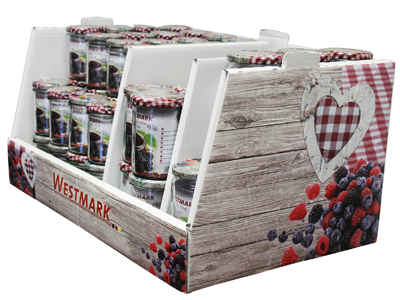Best foreign label at French Digital Label Forum 2015 awards went to this design printed by Etikettenhaus on SPGPrints DSI
Adrian Tippetts explores how three users of SPGPrints’ 330 mm wide Digital System Integration (DSI) press have succeeded in profiting from adding digital to their portfolio in the last three years.
With a significant shift towards shorter runs, more flexible service and greater personalisation, UV inkjet offers significant potential, thanks to its resilient inks and ability to give high performance on film as well as paper substrates. According to SPGPrints, the Dutch makers of the Digital System Integration (DSI) inkjet printer, successfully adopting the process requires a mix of application appropriate press specification, finely tuned inks, software and long term support from the press builder.
Bas Hoijtink, commercial manager graphics, said, ‘The printer needs to assure identical quality to analogue print processes, and become adept at handling an increased number of jobs, at short notice without losing production time. Furthermore, through variable data and unique prints, the digital process brings strategic benefits, way beyond the cost of the label itself. That’s why our approach in helping printers gain maximum value from a digital workflow, goes beyond high specification press, fine-tuned inks and automated software. It includes long term support, which involves training, a service network with round-the-clock availability, and high-level consultancy, to advise customers on how to offer new digital label services.’
Modularity is the key to a customised press suited to application, budget and level of throughput. There are three degrees of modularity. The first is width, ranging from 200 mm to 555 mm (8-21.8 inches), with 330 mm (13 inches) preferred by most label printers. At maximum width, and with a top speed of 35 m/min, productivity of up to 700 sqm/hour is possible.
The second is the number of printing stations. SPGPrints, for example, offers the option to add up to six extra stations to the basic CMYK: orange and violet to replicate over 90% of the visible colour spectrum, opaque white, specially formulated spot colours, or a digital primer, to maximise substrate compatibility.
The third concerns post-print processes, making it possible to bring coating and die-cutting inline, and thus create a platform for a single pass label production. A scalable press offers the safest long term solution: the chance to extend it with extra width, print stations or converting processes at a later date, as the business needs change.
Higher specification is the basis for fast throughput and high quality, especially when printing on film. Two features important features on the DSI are intermediate LED pinning, stabilising the ink layer the moment it is deposited on the substrate, and a watercooled chill drum to control the temperature and stop distortion of heat-sensitive plastic substrates.
Meeting demands
When Québec City, Canada-based label converter Multi-Action Labels sought to meet the growing demand for short runs by installing a digital printer with pinning and chiller standard, was an important factor in the investment decision. Installed in 2012, the eight colour 330 mm DSI, with orange, violet, opaque white and a digital primer, coater and die-cutter, complements three ETI flexo presses.
About a quarter of Multi-Action’s output comprises temperature-sensitive film substrates, including unsupported PET, polypropylene and polyethylene. The chiller means the company can run this material in thinner gauges through the machine without compromising speed, while intermediate LED pinning enables crisp, small characters and fine linework, without the need to alter the press speed. 
Maple syrup labels printed by Multi-Action Labels on its DSI UV inkjet press
The optional primer increases substrate flexibility, including machine-coated papers. There is no need for more expensive, specially treated facestocks; application is controlled and restricted to the intended image area. As a result, Multi-Action is achieving high quality results on Kraft and, for VDP barcode printing, woven paper. With the press, the company achieves identical results to its flexo presses, meaning that the size of the order alone determines whether the job will be run by analogue or digitally.
Inkjet inks’ durability make them ideal for industrial as well as retail goods applications. High performance of SPGPrints’ proprietary inks was critical for Wisconsin, USA-based McLoone, which supplies nameplates and stickers to electronic goods makers, mainly for warranty, safety and identification purposes. The company has made major cost savings by transferring a third of its flexible label production to a standalone four colour DSI printer that complements 12 existing flatbed screen presses.
Keith Rosenthal, vice-president of manufacturing at McLoone, said, ‘Industrial labels must perform for several years, perhaps resisting abrasion in the logistics chain, extreme weather and sunlight, water and corrosive chemicals. We subject samples to accelerated weathering [QUV] tests for outdoor durability, and a range of chemicals, including household and industrial chemicals and detergents. The ability of SPGPrints’ inks to withstand these conditions was a principal reason for investing in the DSI press.’
Support makes the difference
The big challenge for printers moving from analogue to digital is to learn about file handling. With training from the press builder, the pre-press department learns how to extract XML files, generate job specifications automatically and programme step and repeat information. With an automated software compatible with both existing analogue workflows and the company’s own management information system, digital printing can reduce pre-press times to 15 minutes and allow dozens of jobs to be programmed consecutively, without startup waste.
Repeat orders are easily retrieved from the system and scheduled in moments. Support – in terms of training and remote diagnostics – from the press builder together with powerful software is essential in integrating the digital workflow smoothly, and achieving a fast return on investment.
This was especially true at Multi-Action, where the number of jobs managed by the company per year rose from 2500 in 2010 to nearly 6000 in 2014. With the help of the press manufaturer, it took Multi-Action about six months to master the digital process. Owner Jonathan Bourbonnière explained, ‘To begin with, the sales representative flew over from Holland with samples to show how they could differentiate themselves, giving workshops on how to print on difficult substrates. Soon after, the service and installation team gave thorough practical training sessions, making sure operators and managers were intimate with the press.’
Multi-Action takes advantage of SPG’s technological and technical first line support, which is offered free of charge, without the need for a contract. One member of staff attended an intensive week-long course at SPGPrints’ Technology Center, at the Boxmeer headquarters, and is now fully trained to deal with any troubleshooting issues on site.
Variable data bring savings
Digital printing opens up numerous ways of adding strategic value to the end-users business – and the guidance of the press manufacturer plays an important role. ‘SPG shared their vision for the VDP market with us, and how we could enter new applications like that. They make a big effort to ensure we are exploiting the technology to the full,’ added Mr Bourbonnière.
Multi-Action offers serialised labels that improve supply chain efficiency. One example includes a contract to supply a million unique barcodes to a department of the Quebec government, allowing warehouse staff to locate and track products easily through the logistics chain.
With a five colour DSI machine as its sole press, German label converter Etikettenhaus, of Hilden near Düsseldorf, has successfully focused its business on supplying serialised, short runs of labels to the food industry and German retail chains.
The press’s ability to offer variable data means Etikettenhaus can provide point-of-sale branding solutions and batch traceability for multiple stock-keeping units, with a level of flexibility not achievable with conventional printing methods. In one example, the company supplied a set of three four-colour point-of-sale labels, applied to point of sale boxes for a national German packaging assembler and wholesaler. Printed on Herma super-white paper, the labels are applied to the front and sides of corrugated packages containing the retailer’s own brands of jams.
Using a common-sized label and template based on customer branding guidelines, Etikettenhaus makes design changes and add serial numbers with ease and at very short notice for each job. The company supplies up to a thousand batches, each comprising a thousand identical labels with the their own batch number.
Udo Sobkowiak, owner and co-founder of Etikettenhaus, commented, ‘Using the software, we are able to schedule several jobs consecutively – sometimes as many as 40 in a day. In this way we provide an effective safety control for popular brands, enabling any problems to be linked to a specific batch, thereby limiting losses in the unlikely event of a recall.’
He concluded, ‘The digital inkjet process was an essential part of our business concept, because it was the most reliable and economical means of supplying both short runs and thermal transfer labels.’






